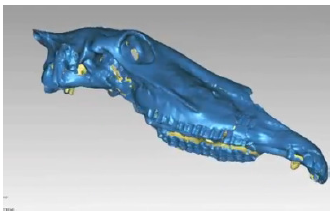 The National Park Service’s Hagerman Fossil Beds National Monument in Idaho contains the largest concentration of Hagerman Horse (Equus simplicidens) fossils in North America. It is nationally and internationally significant for its world-class paleontological resources including the world’s richest fossil deposits, in quality, quantity, and diversity, from the late Pliocene epoch. Many of its fossils represent the last vestiges of species that existed before the last Ice Age, the Pleistocene, and the earliest modern flora and fauna.
The National Park Service’s Hagerman Fossil Beds National Monument in Idaho contains the largest concentration of Hagerman Horse (Equus simplicidens) fossils in North America. It is nationally and internationally significant for its world-class paleontological resources including the world’s richest fossil deposits, in quality, quantity, and diversity, from the late Pliocene epoch. Many of its fossils represent the last vestiges of species that existed before the last Ice Age, the Pleistocene, and the earliest modern flora and fauna.
The NPS paleontologists at the Fossil Beds were curious about the technology of 3D scanning, but had never used it in their research. They were interested in finding out more about its educational applications and how their research could benefit from its use.
Fortuitously, while attending a conference where Laser Design and GKS Services Corp was performing demonstration 3D scans, one of the paleontologists who had brought along a three million-year-old horse skull, was able to experience 3D scanning on-site and have GKS scan the skull with the portable Laser Design Surveyor FA system.
 The Surveyor FA system consisted of a 7-axis FARO Quantum 8-foot arm with the Laser Design high-accuracy SLP-500 non-con tact laser probe.The horse skull artifact was approximately 24”l x 10”w x 10”h. Scanning time was about 30 minutes. The 3D scan captured the myriad details of the object’s profile including minute fossils embedded in the bone along with each individual horse tooth. Laser Design’s proprietary scanning software, ScanControl, and Geomagic software were used to scan, refine, and create an STL model for viewing and measuring. This type of file can also be used for reverse engineering the object with rapid prototyping systems.
The Surveyor FA system consisted of a 7-axis FARO Quantum 8-foot arm with the Laser Design high-accuracy SLP-500 non-con tact laser probe.The horse skull artifact was approximately 24”l x 10”w x 10”h. Scanning time was about 30 minutes. The 3D scan captured the myriad details of the object’s profile including minute fossils embedded in the bone along with each individual horse tooth. Laser Design’s proprietary scanning software, ScanControl, and Geomagic software were used to scan, refine, and create an STL model for viewing and measuring. This type of file can also be used for reverse engineering the object with rapid prototyping systems.
The non-contact Surveyor 3D laser scanning system’s patented line-laser probe technology dramatically reduces scanning time by collecting data significantly faster and more accurately than with other technologies. Because the laser scanning system projects a line of laser light onto surfaces while cameras continuously triangulate the changing distance and profile of the laser line as it sweeps along, the problems of missing data on irregularly shaped surfaces is greatly reduced. The system measures fine details and captures complex freeform geometry so that the object can be exactly replicated digitally.
3D scanning is an invaluable tool for paleontologis ts and archaeologists because it is fast, ultra-accurate, and non-destructive. Nothing physically touches the fossil except the safe laser light. The data collected by the Laser Design Surveyor system are extremely detailed, allowing for very thorough inspection of the artifact. Since the scan captures objects from every angle, the data can be rotated 360 degrees to measure, manipulate, magnify, and compare dimensions in 3D for educational and research purposes. The digital data can be shared amongst researchers and students worldwide, allowing access to valuable resources in the global scientific community without having to ship priceless artifacts to other locations. Alternately, if an actual physical model is needed, the data can be used to create an exact replica of the fossil, and that can be sent to researchers in lieu of the valuable fossil itself. The applications of 3D scanning technologies to researchers are virtually limitless.
“We haven’t yet had the chance to come up with many applications for 3D scanning,” commented the Hagerman paleontologist. “With some creativity, having digital models could be a very valuable asset to our educational and research programs in the future.”
